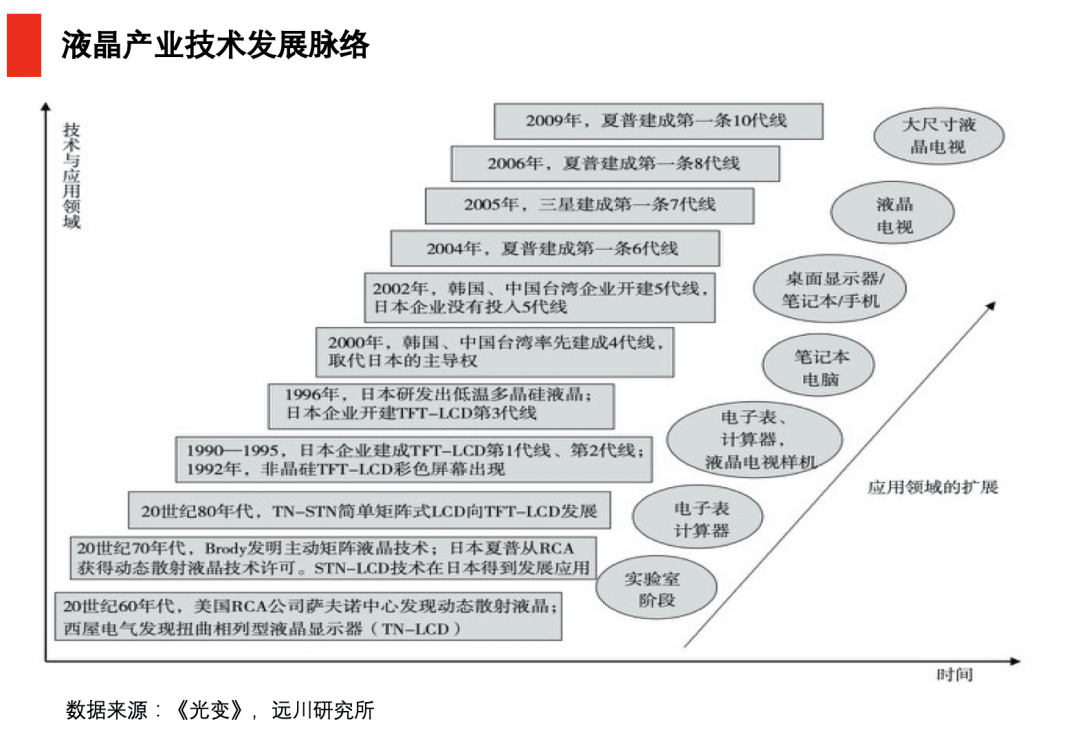The development context of LCD industry technology

human beings have 80% information from vision in their daily life. Therefore, the research and development of display technology has always been valued by enterprises and scientists and engineers in various countries.
, which is simply to use an electron gun to emit electrons to impact phosphors to display. "Dafangtou" TV and computer display screens are all its applications. In the field of CRT, Japanese companies relied on the craftsmanship of "striving for perfection" to create TV sets that are "resistant to falling more than a dozen times", and soon became the industry hegemon. Sony's "Trinitron" has sold more than 0.1 billion units worldwide, beating its competitors.
CRT technology, the dynamic response is very fast, but its shortcomings are also obvious, requiring a certain volume and thick glass; when the display area reaches more than 30 inches, it is already close to 100kg. Weight becomes an important obstacle to limiting the display area. During the evolution of CRT to LCD, technologies such as PDP (plasma) and FED (field emission) were still advancing, but eventually failed. There are three reasons for LCD's victory: it is most connected to the "earth", and it has been commercialized early with primary technology, and the spiral of "profit-research and development" has been started; the latest trend, digital watches have become popular electronic products, and this is obviously a scenario that CRT cannot achieve; it is most in line with the ultimate demand. From a theoretical point of view, it is easier to achieve thin and large sizes. That is, despite the twists and turns of the road, it is ultimately bright.
At the beginning of 2000, LCD LCD TV gradually came out.
LCD technology was invented by RCA in the United States around the 1960s. However, due to the immature technology in the early stage, it is difficult to produce large-size products, so it has not been paid attention to by American enterprises. It has been in a "desolate state" for a long time, and even thinks that "it is absurd to establish a LCD screen the size of a TV screen". But Japanese companies are very interested. They used LCD technology for small digital watches, which was a great success, and then opened the road to LCD TV.
In 1988, Japan's Sharp Company successfully manufactured a 14-inch LCD TV sample, igniting the industry's accelerator. The first generation line, the second generation line, and the third generation line have been opened one after another. Subsequently, South Korea, Taiwan, and China all joined the battle for LCD liquid crystal, continuously expanding the production size of LCD panels and optimizing the production process. However, Japanese enterprises are ahead of the United States and finally win the LCD industry for three reasons: "Learning Network", Japanese enterprises entered the market one after another and kept sharing in the competition, forming a knowledge network of experience and technology."Industrial Cluster", Japan has also formed an upstream and downstream system, with enterprises participating in almost every link. The glass substrate includes Asahi Nitron, etc. Photolithography machines include Nikon and Canon. Color films and polarizers include TEPCO and so on."open ecology",IBM, Philips, Corning and so on are all important forces in the rise of Japanese LCD.
by contrast, the United States has shown a trend of independent innovation and closed system in LCD research and development, and finally "beat" almost disappeared in the industrial cycle. However, Japan's leadership in the LCD industry does not mean once and for all.
in the choice of the fifth generation line around 2000, Japanese enterprises hesitated because of financial pressure and market prospects. South Korea's Samsung, LG and other companies have bucked the trend, not only paying for factories, but also digging people from Japanese companies. In the end, in the doubt that Japanese companies ridiculed as "Titanic", South Korean companies ushered in a rebound in demand. Quickly seize the market, and step by step increase investment to achieve the lead.
from the second half of 2019, South Korean panel enterprises began to close LCD production lines one after another, and Samsung Suzhou factory was also sold to TCL. After more than 10 years of ups and downs, China's panel industry has gradually stepped onto the center of the world stage, with a share of 50% in the LCD field, and the pattern of BOE and TCL Huaxing Optoelectronics has also emerged.
talk about the achievements of our country's panels today, many people will simply attribute it to "throwing money and fighting for scale"; there is no doubt that we have reverse investment and have also played a scale effect. However, whether it is the initial "acquisition of production lines" or the subsequent "independent construction", the domestic panel industry has never stopped its pace on the road of technological research and development. But also from the introduction of technology, step by step to follow, gradually to the frontier exploration, part of the lead.
So in summary, the technological changes in the panel industry and the switching of dominance can be summed up in four points: strategically, it must be close to demand, but it must be a small step ahead of the demand market and be deployed in advance; in terms of mentality, It is necessary to widely adopt cooperation and cultivate upstream and downstream ecology; in terms of resource reserves, there must be a talent reserve to achieve technological research and development and process improvement; more importantly, there must be"Benign Spends Money"not only has sufficient capital, but also commercial profits to promote the long-term cycle.
by comparison, after more than ten years of development, the innovation strength of my country's panel industry has been greatly enhanced: good process experience and talent team have been accumulated; the industrial chain has also developed. The upstream has Sanan Optoelectronics, Han's Laser, Shanshan shares, etc. have made breakthroughs in materials, equipment and other fields, while the downstream fields, whether it is mobile phones, TVs, notebooks, or smart cars, China is the largest market, chinese enterprises are already the backbone of the industry.
In terms of capital, due to the advancement of technology, the amount of capital invested in research and development and property insurance is also increasing. With the stability of the LCD pattern, industry profits continue to improve, which is also conducive to BOE, TCL Huaxing Optoelectronics and other industry-leading companies to explore cutting-edge technology. Especially under the impact of the epidemic, China's supply chain is the first to recover, will also strengthen the attractiveness of overseas business cooperation.
LCD industry has also seen two improvements in the past ten years.:is the continuous improvement of generations and the continuous expansion of size. The second is the development of backlight. Looking back on the development of all technologies, no matter how much the terminology is, the essence is one, trying to meet the needs of consumers: from TV to computer, from mobile phone to wearable, from outdoor advertising to in-car central control, the scene is more diversified, and it also corresponds to the needs of power consumption, softness, size and thickness. And more real visual effects.
Therefore, to judge whether a technology has a better future, on the one hand, it is to judge whether it conforms to the consumption trend, on the other hand, it is the feasibility of commercialization.











